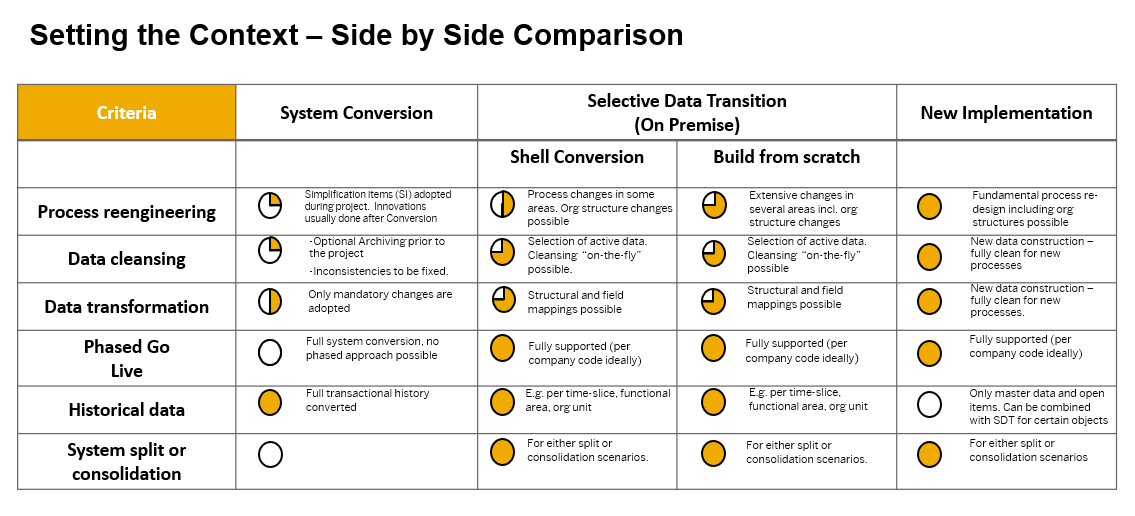As businesses worldwide strive to embrace digital transformation, SAP S/4HANA has emerged as a leading choice for organizations seeking to leverage intelligent technologies and gain a competitive edge. While migrating to SAP S/4HANA offers numerous benefits, the process can be complex, especially when dealing with large amounts of historical data. That’s where Accely’s approach to SAP S/4HANA with Selective Data Transition comes into play. Accely is a leading SAP implementation partner that specializes in helping organizations with their transition to SAP S/4HANA.
In this blog post, we will explore how Accely helps organizations navigate this transition, unlocking the full potential of the intelligent enterprise.
To migrate from the existing SAP ERP to SAP S/4HANA, all data from the old system must be converted completely and moved to the new environment. Nevertheless, this procedure can be time- and resource-consuming, resulting in prolonged downtimes and delays to corporate operations. A more flexible option is provided by selective data transition, which enables organizations to pick and choose which data to move to SAP S/4HANA.
Here are some of the main advantages of this approach:
Reduced Complexity: Businesses can streamline the migration process and eliminate unwanted data replication or integration complications by only transferring relevant data.
Faster Time-to-Value: A quicker S/4HANA selective data transition and a quicker realization of its benefits are made possible by selective data transfer, which enables organizations to move key data first.
Cost Optimisation: Businesses can lower storage expenses, cut down on the amount of hardware needed, and lower overall project costs by only moving the most crucial data.
Improved Data Quality: The new SAP S/4HANA system will have better data quality thanks to the possibility provided by selective data transition to clean up and improve data before migration.
Accely’s Selective Data Transition Methodology
Source: https://blogs.sap.com/2020/02/12/move-to-sap-s-4hana-with-selective-data-transition/
Accely follows a systematic and rigorously tested SAP Selective Data Transition process to ensure a seamless and successful migration to SAP S/4HANA. The strategy comprises the following key steps:
Discover
- Initial Data and Process Analysis: As a first step, initial analyses of data and processes are carried out. This involves assessing the existing data structures, data quality, and process flows to identify any areas that need improvement.
- Migration Assessment: In the second step, a Migration Assessment is executed to define the data transition requirements. This assessment determines the relevant migration objects, data usage patterns, and data volume to be migrated.
- Work-Split and Responsibilities: Depending on the results of the Migration Assessment and the degree of functional changes required, the work-split and responsibilities of the project team are elaborated. Selective Data Transition projects typically require significant involvement from functional resources and key decision-makers, in addition to IT personnel.
- System Landscape Setup and Sizing: Based on the results of the analysis, a recommendation for the future system landscape setup and sizing is provided. This includes determining the hardware requirements for a test system that is comparable to the production setup. Having a test system with similar hardware allows for fast and reliable transition results, enabling thorough testing and validation of the migration process.
Prepare
- Setup of Transition Landscape: The transition landscape is set up, which includes the installation and configuration of the required hardware and software components. This involves provisioning the necessary infrastructure, such as servers and storage, and ensuring the availability of the target S/4hana selective data transition.
- Installation of Transformation Software: The transformation software, specific to Selective Data Transition, is installed in the transition landscape. This software facilitates the data extraction, transformation, and loading processes during the migration.
- Detailed Transition Activity Plan: A first version of a detailed transition activity plan is developed. This plan outlines the step-by-step activities and tasks involved in the migration process, including data extraction, cleansing, transformation, and loading. It also includes a timeline, dependencies, and resource allocation to ensure a structured and organized transition.
- Testing Strategy and Test Scenarios: A specific testing strategy is defined, encompassing the approach and methodologies for validating the migration. Test scenarios and test cases are identified and documented to ensure thorough testing of the migrated data and processes. This includes functional and technical testing to verify the accuracy, integrity, and performance of the data in the SAP S/4HANA system.
Explore
- Fit Gap Analysis and Data Transition Design: The results of the fit gap analysis, which identifies the gaps between the existing SAP ERP system and SAP S/4HANA, are gradually transferred to the data transition design. This design outlines how the selective data transition will take place, using specially developed transformation sets.
- Validation and Adaptation of Data Transition Design: In the course of the data transfer, the data transition design is validated and adapted as needed. This validation involves transferring data using the transformation sets and ensuring the accuracy and integrity of the migrated data. Any necessary adjustments to the design are made to optimize the outcome of the migration.
- Framework Definition for Cutover: The Explore phase is also the opportune time to define the framework for the cutover, which refers to the final transition from the existing SAP ERP system to SAP S/4HANA. This includes identifying the key activities, timelines, and resources required for a smooth cutover process.
- Translation to Physical Data Extraction and Load Processes: The data transition design is translated into physical data extraction and load processes. This involves specifying the technical details of how the data will be extracted from the source system, transformed, and loaded into the target SAP S/4HANA system.
Realize
- Implementation of Final Changes: The final changes derived from the data transition blueprint are implemented in the transformation software. These changes are based on the requirements and specifications outlined in the design transition document. The implementation ensures that the software aligns with the specific data transition needs of the project.
- Stability and Testing of Data Transition: The continuous stability of the data transition requirements is essential for a smooth process. Testing is conducted to verify the accuracy and integrity of the data transition. It is crucial to perform multiple complete data transitions (test cycles) to ensure thorough testing and validation of the migration.
- Complexity and Duration: The duration of the Realize phase varies depending on the complexity of the data transition scenario. Regardless of the project’s scope and difficulty, it is generally recommended to conduct at least two complete data transitions, followed by an end-to-end process test.
- Updates to Design Transition Documents: Based on the test results, the data transition rules and settings in the design transition document are updated if necessary. This iterative process allows for refinements and improvements to be made based on the testing outcomes, ensuring that the data transition aligns with the desired objectives.
Deploy/Run
- Simulating Go-Live and Cutover: In this phase, a simulated go-live is performed based on the cutover plan defined in advance. The cutover plan outlines the specific steps and timelines for transitioning from the existing SAP ERP system to the newly migrated SAP S/4HANA system. By simulating the go-live process, any issues or challenges can be identified and addressed before the actual go-live event.
- Final Business Testing: Once the simulated go-live is completed, the final business testing is conducted. This testing phase involves validating the functionality and performance of the system in a real-world scenario.
- Incorporating Latest Findings: The Deploy/Run phase takes into account the latest findings and feedback from the previous phases. Any necessary adjustments or refinements identified during the testing and simulation are incorporated into the final test run.
- Release for Production: After completing the final business testing and addressing any issues, the system is released for production. This means that the migrated SAP S/4HANA system is ready to be used in the live production environment, enabling organizations to leverage the benefits of the new system and its enhanced capabilities.
Why Choose Accely as Your Implementation Partner
Expertise and Knowledge: Accely’s team comprises seasoned SAP consultants with deep domain expertise and a thorough understanding of the complexities involved in SAP S/4HANA migration projects.
Customer-Centric Approach: Accely places customer satisfaction at the forefront of their engagements. They actively collaborate with clients, aligning their solutions with business objectives and tailoring the migration process to meet specific requirements.
Proven Methodologies: It follows a well-defined methodology for Selective Data Transition, ensuring a structured and efficient migration process. Its approach minimizes risks, reduces downtime, and maximizes the value derived from SAP S/4HANA.
End-to-End Support: Accely provides comprehensive support throughout the migration journey, from initial assessment and planning to post-migration activities.
Conclusion
Migrating to SAP S/4HANA with Selective Data Transition offers organizations the opportunity to optimize their business processes and leverage real-time insights while minimizing complexity and downtime. Accely’s approach to SAP S/4HANA migration brings immense value to businesses by providing a controlled and phased migration process that focuses on critical data subsets.






